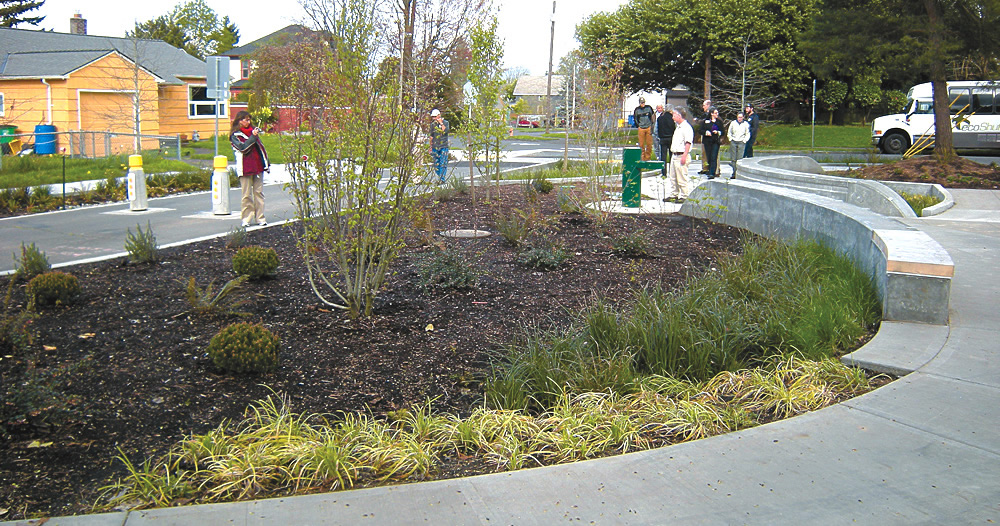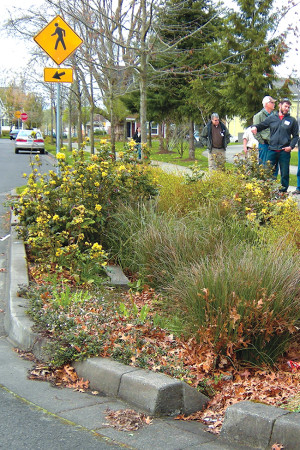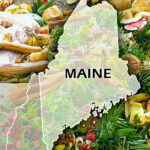Transitions to practices such as green storm water infrastructure, grey water use and recycling treated wastewater are becoming more common. Part II
Sally Brown
BioCycle May 2014
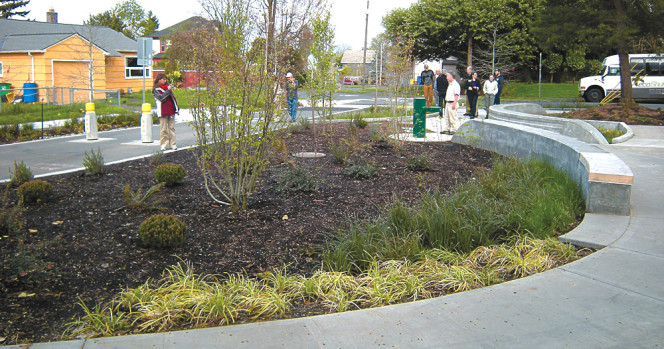
Green storm water infrastructure, such as this rain garden in Portland, Oregon, is becoming increasingly common to capture and infiltrate rainwater. Compost is often used in the engineered soil mixes for the rain gardens.
News headlines tend to focus on the agricultural impacts of water shortages. But urban areas have their own challenges in times of water shortages. People depend on consistent supplies of potable water for drinking, cooking, washing, watering and flushing. While quantities vary, an average person in the U.S. uses about 100 gallons of water each day, according to the U.S. EPA’s Water Sense program. Potable water is typically supplied by municipal agencies and utilities. Different municipal agencies and utilities are tasked with cleaning up the very same waters when we are done using them.
These agencies and our water infrastructure were developed with public health as the number one overriding factor. They were also developed back when energy was cheap, water was plentiful and engineered solutions were taken to be as shiny as the steel that was used to build them. Times have changed. While public health is still a paramount concern, both water and energy are now understood to be precious resources that have their own impacts on public health. It is time to revisit water use in urban areas.
Let’s start with a review of the water cycle in natural and urban areas. In natural systems, rains fall from the skies and land on the ground. All of the surfaces in these systems are water permeable and so the majority of water soaks into the soil. The speed of the water is slowed by grass and leaves as it hits these surfaces. This makes it less prone to disrupt the soil surface and cause erosion when it lands. If there is too much water to soak in, the water flows overland to streams, rivers and lakes. Even with overland flow, the majority of flow into these water bodies tends to come from water that has infiltrated into the soils. ‘Subsurface’ flow takes water along a long and circuitous journey before it is released. This means that stream flow stays pretty consistent through seasons and storms. It also means that the water that enters the streams does not come carrying coffee cups or other debris. And it also means that it is not too hot or too cold for the stream as the water’s temperature has come into equilibrium with the soil.
Water in urban areas typically travels on the express lanes of a superhighway, avoiding the local scenic route. Potable water is brought via pipes from watersheds that are natural water collection areas owned and maintained by cities. Sometimes water is removed directly from rivers and treated to potable standards. Used water is piped to treatment plants where, once treated it is released rapid fire to rivers or oceans. Water that actually falls directly on cities (aka rain and snow) is also transported directly to natural water bodies through overland flow or via storm sewers. It can also be transported to wastewater treatment plants. The goal of storm water infrastructure in urban areas has traditionally been to keep water out of soils and streets by moving it as quickly as possible. This infrastructure has been developed to protect the public from nonpotable water and to safeguard against inefficiencies associated with standing water.
The whole system works well if you have water to spare. Use it once and throw it away has been the mindset. While gently used water is not appropriate for people to drink, it is well suited for a number of beneficial uses including watering gardens and flushing toilets. For previous droughts, much of the emphasis has been on water conservation. Conservation is key, but there are other ways that water in urban areas can be repurposed to make the most out of limited fresh water and energy resources. These apply to both individuals and municipalities. Using water multiple times or intercepting it for use before it is removed from the system are both ways to effectively increase available water supplies.
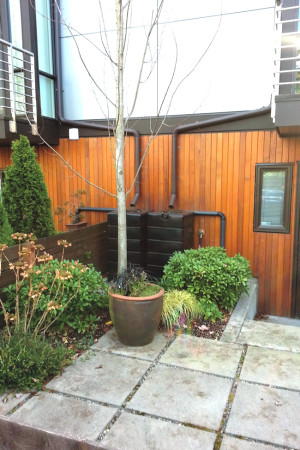
Rainwater harvesting is the term used to collect water from storms. Homeowners and businesses can run drain pipes from the roof into cisterns or rain barrels.
Domestic Options
Rainwater Collection: Rainwater harvesting is the term used to collect water from storms. Water can be collected by homeowners or businesses from roofs for later use. When collected from roofs, storm water is generally clean. The only contaminants are those that become dissolved or are carried by the water as it flows off of roofs into cisterns or rain barrels. Depending on the end use of the water, it may be advisable not to collect water from the first flush after a dry period as particulates may accumulate on the roof surface. Many municipalities or states have guidance for storm water collection and actively encourage the practice (NCSL, 2013). Texas has the most sophisticated guidance documents going into detail about suitability of different types of roof surfaces for collection, expected quantities of water that can be expected and types of storage for collected water (Texas Water Development Board, 2014).
It is enlightening to calculate how much water can be collected from a home roof. A general equation for this will let you estimate the quantity of water you can collect:
Annual rainfall (inches) x area of the collection surface (sq ft (SF)) x 144 sq inches/SF x 0.00433 gal/cubic inch x 0.85 collection efficiency = water available for harvesting.
From a home with a 1,000 sq. ft. roof in an area where annual rainfall is 20 inches, this equation predicts that you could collect close to 16,000 gallons/year or likely enough to water your lawn.
Grey Water Use: Grey water is the term used to describe water that has been used in homes from all sources other than toilets. Of the 100 gallons of water used per person per day, about 75 percent falls into the grey water classification. The other 25 percent goes for flushing toilets. This includes water from sinks and showers as well as water from washing machines. Diversion of grey water from wastewater pipes to direct beneficial use without treatment is prohibited in most states. This is the case because of the concern that the water may contain pathogens.
A few states, however, have instituted policies that allow for grey water use prior to treatment. Arizona has the least restrictive regulations. Colorado, California, North Carolina and Washington also have recently allowed grey water use. Toilet flushing and irrigation are both logical end uses for grey water. If grey water were used for toilet flushing, an immediate 25 percent reduction in domestic water use would be realized. If water is used for irrigation, soil bacteria will kill any pathogens in the grey water if given sufficient time (typically measured in days rather than months). In addition, keeping the water from directly contacting the edible portions of garden crops is a simple way to alleviate any concerns.
Municipal Options
Storm Water: Green storm water infrastructure, alone or in combination with grey (engineered) systems, is increasingly common. The goal of these systems is to incorporate the natural process of infiltration of rainwater into soils with subsequent subsurface flow to natural waterbodies into storm water management. The benefits of these systems are manyfold and include reduced capital and operating costs for engineered infrastructure, increased access to green space with associated benefits, and enhancement of hydrological cycles in urban areas.
From a water conservation perspective, the most important aspect of these systems is enhancement of the hydrologic cycle in urban areas. Engineered storm water infrastructure in urban areas has a major impact on water flows to streams. In natural systems, water from rain enters streams gradually. While there may be a first flush from a heavy rain with water that flows to streams over the soil surface, the majority of the rain enters the streams gradually over time, via subsurface flow. Subsurface flow has many benefits in comparison with overland flow. Water that travels through soils moves slowly and is filtered in the process. This reduces the potential for flooding and for sediment deposition in streams. It also regulates flow levels so that stream depth is more consistent over time. All of these factors enhance the ecological functions of streams and make them better habitat. This mitigates the impacts of both droughty cycles and high flow rainfall events.
Reclaimed Water: Reclaimed water is water that has been treated to beneficial use standards in centralized wastewater treatment plants. Wastewater treatment plants have typically been constructed down slope and in close proximity to natural water bodies as a way to reduce pumping costs for getting influent to the plants and treated effluent from the plants. These plants benefit from a predictable quantity of water of a predictable quality coming for treatment every day. For example, the treatment plants in King County, Washington service about 1.5 million people and have annual flows into their treatment plants of 180 million gallons/day (King County, 2013). That is equivalent to 15,900-acre feet/day or 5.8 million acre feet/year, which comes to about 3.9 acre ft/person/year. The water has to be treated to reach effluent discharge standards. The additional treatment required for beneficial use is minor in comparison.
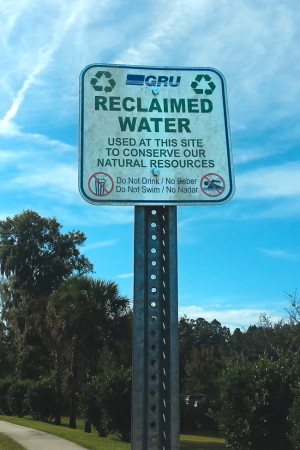
Reclaimed water has been treated to beneficial use standards in centralized wastewater treatment plants. End uses include agricultural, golf course and landscape irrigation, and groundwater recharge.
EPA has recently released guidance on use of reclaimed water (EPA, 2014). Many states also have regulations governing use of reclaimed water. The heaviest uses of reclaimed water are in Arizona, Florida, Nevada and California. In California 184,000 acre-feet of reclaimed water was used in 1977. By 2009, that was up to 669,000 acre-feet (CA Water Resources Control Board, 2009). End uses include agricultural irrigation (37%), golf course and landscape irrigation (23%) and groundwater recharge (12%). Certain parts of the state, including the San Diego and San Francisco regions, use very little of their wastewater effluent. If the same quantity of wastewater per person is treated in California as is in King County, that would mean that a total of 147 million acre feet is generated and that reuse of a larger portion of this would result in significant conservation of water resources.
One of the primary obstacles to greater use of recycled water in urban areas is the infrastructure requirements needed to facilitate that use. For the homeowner, a rainwater collection system can be as simple as a barrel at the end of the rainspout. However, this simple a system does not allow for adequate storage or for ease of use. A more complicated system would involve construction of a water storage tank that is of sufficient size to store water commensurate with end use needs. Linking of that tank to indoor plumbing would facilitate use for toilet flushing. Linking to an irrigation system would allow for easier use for watering. The same can be said for grey water systems. In some cases, grey water from point sources can be plumbed with an on-off switch to connect to an outside hose. However, optimizing use of this resource requires an investment for piping and storage.
On a municipal level, green infrastructure systems are typically much less costly to install than traditional storm water systems. They can be done block by block or in targeted areas. Reclaimed water systems are a different story. As wastewater treatment plants have been sited at low points to facilitate flow into the plants, this means that they will require both piping and pumping to deliver the treated water to end users. This is a significant capital investment that is likely one of the primary barriers to greater end use. As water shortages become more common, however, making these investments now seems like a very good idea.
Sally Brown is a Research Associate Professor at the University of Washington in Seattle and a member of BioCycle’s Editorial Board. Part I of this article, “Compost And Mulch Aid Drought Survival,” appeared in the March/April 2014 issue.


